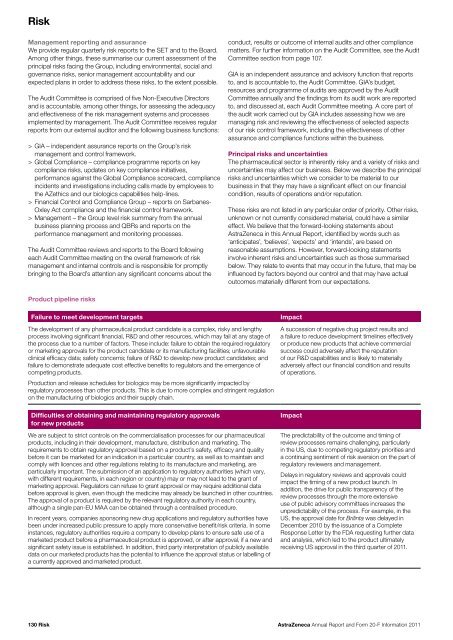AstraZeneca Annual Report and Form 20-F Information 2011
AstraZeneca Annual Report and Form 20-F Information 2011
AstraZeneca Annual Report and Form 20-F Information 2011
- No tags were found...
Create successful ePaper yourself
Turn your PDF publications into a flip-book with our unique Google optimized e-Paper software.
RiskManagement reporting <strong>and</strong> assuranceWe provide regular quarterly risk reports to the SET <strong>and</strong> to the Board.Among other things, these summarise our current assessment of theprincipal risks facing the Group, including environmental, social <strong>and</strong>governance risks, senior management accountability <strong>and</strong> ourexpected plans in order to address these risks, to the extent possible.The Audit Committee is comprised of five Non-Executive Directors<strong>and</strong> is accountable, among other things, for assessing the adequacy<strong>and</strong> effectiveness of the risk management systems <strong>and</strong> processesimplemented by management. The Audit Committee receives regularreports from our external auditor <strong>and</strong> the following business functions:> GIA – independent assurance reports on the Group’s riskmanagement <strong>and</strong> control framework.> Global Compliance – compliance programme reports on keycompliance risks, updates on key compliance initiatives,performance against the Global Compliance scorecard, complianceincidents <strong>and</strong> investigations including calls made by employees tothe AZethics <strong>and</strong> our biologics capabilities help-lines.> Financial Control <strong>and</strong> Compliance Group – reports on Sarbanes-Oxley Act compliance <strong>and</strong> the financial control framework.> Management – the Group level risk summary from the annualbusiness planning process <strong>and</strong> QBRs <strong>and</strong> reports on theperformance management <strong>and</strong> monitoring processes.The Audit Committee reviews <strong>and</strong> reports to the Board followingeach Audit Committee meeting on the overall framework of riskmanagement <strong>and</strong> internal controls <strong>and</strong> is responsible for promptlybringing to the Board’s attention any significant concerns about theconduct, results or outcome of internal audits <strong>and</strong> other compliancematters. For further information on the Audit Committee, see the AuditCommittee section from page 107.GIA is an independent assurance <strong>and</strong> advisory function that reportsto, <strong>and</strong> is accountable to, the Audit Committee. GIA’s budget,resources <strong>and</strong> programme of audits are approved by the AuditCommittee annually <strong>and</strong> the findings from its audit work are reportedto, <strong>and</strong> discussed at, each Audit Committee meeting. A core part ofthe audit work carried out by GIA includes assessing how we aremanaging risk <strong>and</strong> reviewing the effectiveness of selected aspectsof our risk control framework, including the effectiveness of otherassurance <strong>and</strong> compliance functions within the business.Principal risks <strong>and</strong> uncertaintiesThe pharmaceutical sector is inherently risky <strong>and</strong> a variety of risks <strong>and</strong>uncertainties may affect our business. Below we describe the principalrisks <strong>and</strong> uncertainties which we consider to be material to ourbusiness in that they may have a significant effect on our financialcondition, results of operations <strong>and</strong>/or reputation.These risks are not listed in any particular order of priority. Other risks,unknown or not currently considered material, could have a similareffect. We believe that the forward-looking statements about<strong>AstraZeneca</strong> in this <strong>Annual</strong> <strong>Report</strong>, identified by words such as‘anticipates’, ‘believes’, ‘expects’ <strong>and</strong> ‘intends’, are based onreasonable assumptions. However, forward-looking statementsinvolve inherent risks <strong>and</strong> uncertainties such as those summarisedbelow. They relate to events that may occur in the future, that may beinfluenced by factors beyond our control <strong>and</strong> that may have actualoutcomes materially different from our expectations.Product pipeline risksFailure to meet development targetsThe development of any pharmaceutical product c<strong>and</strong>idate is a complex, risky <strong>and</strong> lengthyprocess involving significant financial, R&D <strong>and</strong> other resources, which may fail at any stage ofthe process due to a number of factors. These include: failure to obtain the required regulatoryor marketing approvals for the product c<strong>and</strong>idate or its manufacturing facilities; unfavourableclinical efficacy data; safety concerns; failure of R&D to develop new product c<strong>and</strong>idates; <strong>and</strong>failure to demonstrate adequate cost effective benefits to regulators <strong>and</strong> the emergence ofcompeting products.Production <strong>and</strong> release schedules for biologics may be more significantly impacted byregulatory processes than other products. This is due to more complex <strong>and</strong> stringent regulationon the manufacturing of biologics <strong>and</strong> their supply chain.Difficulties of obtaining <strong>and</strong> maintaining regulatory approvalsfor new productsWe are subject to strict controls on the commercialisation processes for our pharmaceuticalproducts, including in their development, manufacture, distribution <strong>and</strong> marketing. Therequirements to obtain regulatory approval based on a product’s safety, efficacy <strong>and</strong> qualitybefore it can be marketed for an indication in a particular country, as well as to maintain <strong>and</strong>comply with licences <strong>and</strong> other regulations relating to its manufacture <strong>and</strong> marketing, areparticularly important. The submission of an application to regulatory authorities (which vary,with different requirements, in each region or country) may or may not lead to the grant ofmarketing approval. Regulators can refuse to grant approval or may require additional databefore approval is given, even though the medicine may already be launched in other countries.The approval of a product is required by the relevant regulatory authority in each country,although a single pan-EU MAA can be obtained through a centralised procedure.In recent years, companies sponsoring new drug applications <strong>and</strong> regulatory authorities havebeen under increased public pressure to apply more conservative benefit/risk criteria. In someinstances, regulatory authorities require a company to develop plans to ensure safe use of amarketed product before a pharmaceutical product is approved, or after approval, if a new <strong>and</strong>significant safety issue is established. In addition, third party interpretation of publicly availabledata on our marketed products has the potential to influence the approval status or labelling ofa currently approved <strong>and</strong> marketed product.ImpactA succession of negative drug project results <strong>and</strong>a failure to reduce development timelines effectivelyor produce new products that achieve commercialsuccess could adversely affect the reputationof our R&D capabilities <strong>and</strong> is likely to materiallyadversely affect our financial condition <strong>and</strong> resultsof operations.ImpactThe predictability of the outcome <strong>and</strong> timing ofreview processes remains challenging, particularlyin the US, due to competing regulatory priorities <strong>and</strong>a continuing sentiment of risk aversion on the part ofregulatory reviewers <strong>and</strong> management.Delays in regulatory reviews <strong>and</strong> approvals couldimpact the timing of a new product launch. Inaddition, the drive for public transparency of thereview processes through the more extensiveuse of public advisory committees increases theunpredictability of the process. For example, in theUS, the approval date for Brilinta was delayed inDecember <strong>20</strong>10 by the issuance of a CompleteResponse Letter by the FDA requesting further data<strong>and</strong> analysis, which led to the product ultimatelyreceiving US approval in the third quarter of <strong>20</strong>11.130 Risk<strong>AstraZeneca</strong> <strong>Annual</strong> <strong>Report</strong> <strong>and</strong> <strong>Form</strong> <strong>20</strong>-F <strong>Information</strong> <strong>20</strong>11










